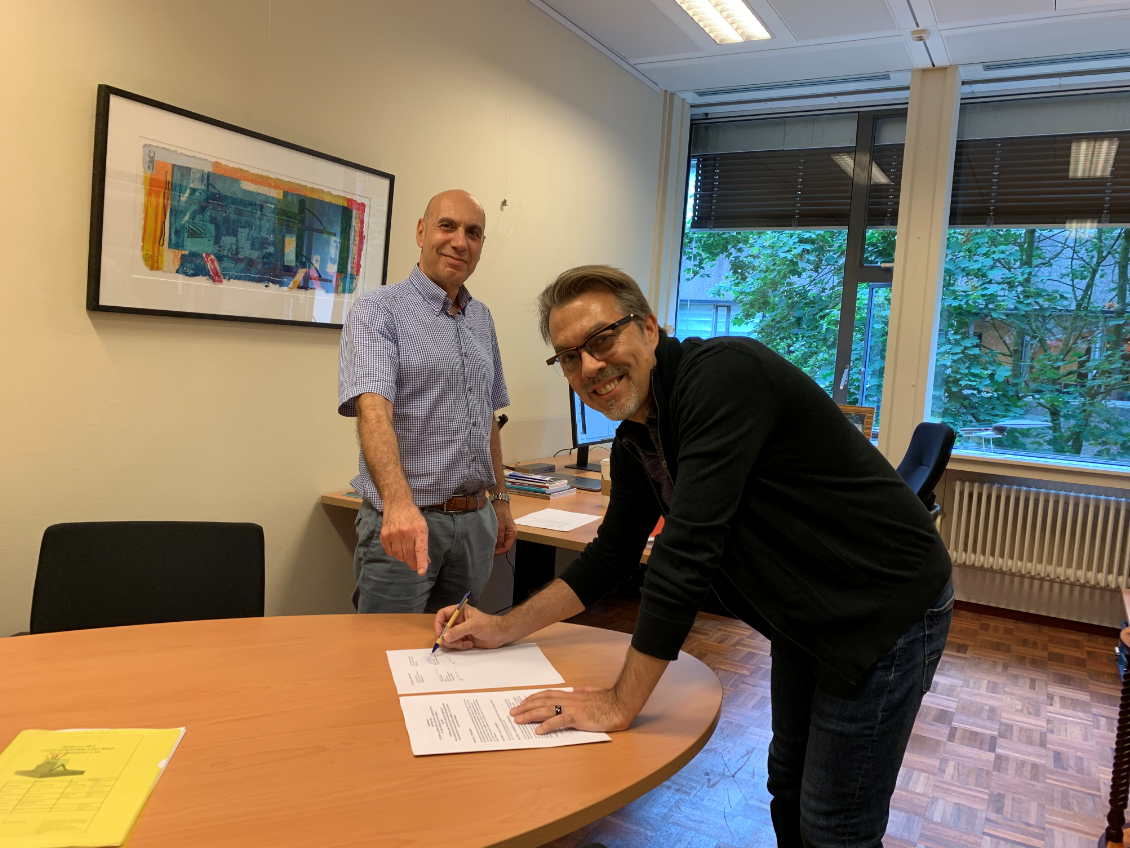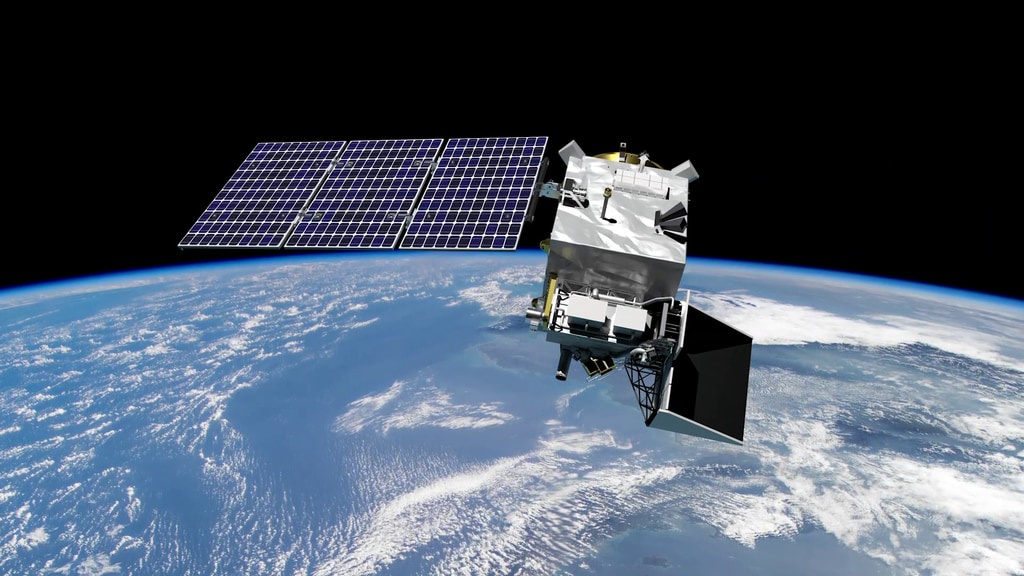(English follows Dutch)
NASA en SRON hebben de overeenkomst getekend waarmee Nederland bijdraagt aan de Plankton, Aerosol, Cloud, Ocean Ecosystem (PACE) satelliet met het SPEXone-instrument. SPEXone zal met ongekende nauwkeurigheid de eigenschappen in kaart brengen van aerosolen in de atmosfeer. Daarmee geeft het antwoord op grote openstaande klimaatvragen. SPEXone brengt de ‘A’ in PACE.

Namens NASA tekende Gilbert Kirkham, Directeur Wetenschap van het Bureau International and Interagency Relations. Michael Wise, Algemeen en Wetenschappelijk Directeur van SRON, tekende namens de Nederlandse partijen in SPEXone.
Aerosolen
SRON is samen met consortiumpartner Airbus Defence and Space Netherlands verantwoordelijk voor de ontwikkeling van het SPEXone-instrument, met ondersteuning van de opto-mechanische expertise van TNO. SPEXone is compact met een gewicht van minder dan 10 kg en zit vol optische vernieuwingen die nog niet eerder in een ruimte-instrument zijn toegepast. Daardoor kan het de invloed van verschillende aerosol-eigenschappen op het klimaat bepalen met ongeëvenaarde nauwkeurigheid. De wetenschappelijke leiding is in handen van SRON. NASA’s Goddard Space Flight Center (GSFC) is verantwoordelijk voor de bouw, lancering en operatie van de PACE-satelliet.
Verantwoordelijkheden
De ondertekening legt de wederzijdse verantwoordelijkheden officieel vast van een samenwerking die al geruime tijd aan de gang was . Dit betreft onder meer de levering van SPEXone door SRON en partners aan NASA en de lancering en het opereren van het grondstation door NASA. Verdere afspraken gaan over de definitie en ontwikkeling van mechanisch/thermische, elektrische en data interfaces tussen de PACE-satelliet en SPEXone, integratie van SPEXone in de PACE-satelliet, testen voorafgaand aan de lancering, dataverwerking, hardware-infrastructuur, data-archivering en distributie van wetenschappelijke data. Tijdens de ontwikkelfases van SPEXone neemt NASA deel aan reviews.
Levering van SPEXone aan NASA staat gepland voor eind 2020. De lancering van PACE staat gepland voor eind 2022.

SPEXone is mogelijk gemaakt door een Nederlandse investering van veertien miljoen euro. Daarvan betaalde het Netherlands Space Office eerst al twee en later nog eens zeven miljoen euro. Overige financiering komt van de Nederlandse organisatie voor Wetenschappelijk Onderzoek (NWO), SRON Netherlands Institute for Space Research en Airbus Defence and Space Netherlands. NASA verzorgt—naast het OCI instrument—de satelliet, de integratie van de instrumenten op de satelliet, de lancering en infrastructuur op de grond. Het HARP-2 instrument wordt geleverd door University of Maryland, Baltimore County (UMBC).
—————————————————————————————-
—————————————————————————————-
NASA and SRON sign agreement for SPEXone aerosol instrument on PACE space mission
NASA and SRON have signed the agreement in which The Netherlands contributes to the Plankton, Aerosol, Cloud, Ocean Ecosystem (PACE) satellite with the SPEXone instrument. SPEXone will map properties of aerosol in our atmosphere with unprecedented accuracy. This provides answers to large open questions regarding Earth’s climate. SPEXone brings the ‘A’ in PACE.

Gilbert Kirkham, NASA’s Science Director of International and Interagency Relations, signed on behalf of NASA. Michael Wise, SRON’s General and Scientific Director, signed on behalf of the Dutch parties in SPEXone.
Aerosols
Together with consortium partner Airbus Defense and Space Netherlands, SRON is responsible for the development of the SPEXone instrument, with support from TNO’s opto-mechanical expertise. SPEXone is a compact instrument, weighing less than 10 kg, and is full of optical innovations that have never been used in a space instrument before. This enables SPEXone to determine the influence of different aerosol properties on the Earth’s climate with unprecedented accuracy. SRON has the scientific lead of the project. NASA’s Goddard Space Flight Center (GSFC) is responsible for the construction, launch and operation of the PACE satellite.
Responsibilities
The signing officially establishes the mutual responsibilities of a collaboration that has been going on already for quite some time. This includes the delivery of SPEXone by SRON and partners to NASA and the launch and operation of the ground station by NASA. Further agreements concern the definition and development of mechanical/thermal, electrical and data interfaces between the PACE satellite and SPEXone, integration of SPEXone into the PACE satellite, pre-launch tests, data processing, hardware infrastructure, data archiving and distribution of scientific data. NASA takes part in reviews during the development phases of SPEXone.
Delivery of SPEXone to NASA is scheduled for the end of 2020. The scheduled launch of PACE is at the end of 2022.

SPEXone is made possible by a Dutch investment of fourteen million euros. The Netherlands Space Office first paid two and later another seven million euros. Other funding comes from the Dutch Research Council (NWO), SRON Netherlands Institute for Space Research and Airbus Defense and Space Netherlands. In addition to the OCI instrument, NASA provides the satellite, the integration of the instruments on the satellite, the launch and the infrastructure on the ground. The HARP-2 instrument is supplied by the University of Maryland, Baltimore County (UMBC).


